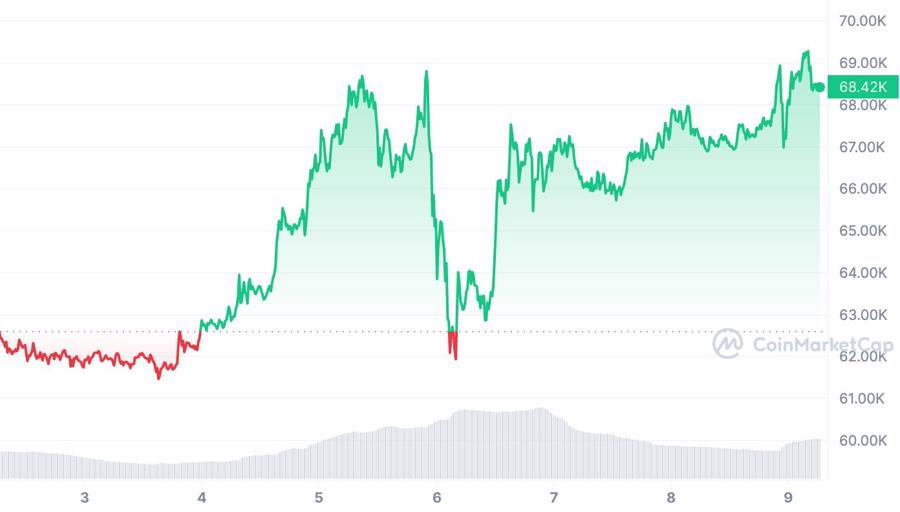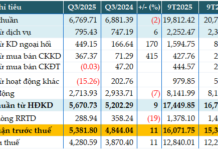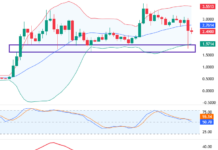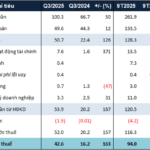The US stock market fell on Friday (March 8) after a volatile week of trading, as investors took profits in Nvidia stocks and faced conflicting signals from the employment report. Crude oil prices also declined, ending a week of losses, while bitcoin continued its upward trend, setting a new record above $70,000.
At the close, the S&P 500 index fell 0.65% to 5,123.69 points. The Nasdaq index dropped 1.16% to 16,085.11 points. Both indices had set intraday records before closing in the red. The Dow Jones index fell 68.66 points, or 0.18%, to 38,722.69 points.
After a steep decline this week, all three indices ended the week with losses. The S&P 500 dipped 0.26% this week, while the Dow Jones and Nasdaq fell by 0.93% and 1.17%, respectively. This is the largest weekly decline for the Dow Jones since October 2023.
Nvidia stocks exerted the greatest downward pressure on the market in this session as investors realized profits from the giant chipmaker’s recent strong gains. Nvidia – the focal point of the AI frenzy on Wall Street – closed down more than 5%, marking its largest decline since late May.
However, Nvidia stocks still rose more than 6% this week – extending an impressive upward trend that has added $1 trillion to the company’s market capitalization since the beginning of the year.
“This decline doesn’t mean that Nvidia’s long-term price potential has run out. It’s just that the stock has risen too fast. Investors are in a situation where they bought too much and now it’s time for them to take profits,” said Sam Stovall, chief strategist at CFRA Research, in an interview with CNBC about Nvidia’s decline.
While Nvidia dragged down the tech sector, Apple shares helped limit the sector’s decline with a 1% increase. With Friday’s gains, Apple ended a 7-session losing streak, the longest losing streak for this blue-chip stock since the beginning of 2022. This week, Apple dropped nearly 5%, becoming the weakest performer among the 30 members of the Dow Jones.
Investors also spent this session pondering the overall employment report for February from the US Department of Labor. The highly anticipated report gave conflicting signals about the timing of the Federal Reserve’s possible interest rate cuts.
The data from the report showed that the number of new non-farm jobs in the US in February exceeded expectations, reaching 275,000 new jobs compared to the forecast of 198,000 new jobs by economists in a Dow Jones poll. This figure is a sign that the economy may still be experiencing strong growth.
On the other hand, the unemployment rate unexpectedly rose slightly to 3.9% due to more people actively searching for employment, and wage growth was weaker than expected. These are signs that inflation has subsided enough to persuade the Fed to begin cutting interest rates. In addition, January’s job growth was also revised down from the initial announcement.
“Overall, people can derive any message they want from today’s employment report. However, we believe the data leans toward positive and will give the Fed enough confidence that a mild rate cut is appropriate,” said George Mateyo, director of investments at Key Private Bank, in an interview with CNBC.
WTI crude oil futures in New York fell $0.92 per barrel, or 1.17%, to $78.01. Brent crude futures in London fell $0.88 per barrel, or 1.06%, to $82.08.
Oil prices dropped this week due to concerns about declining energy consumption in China and the International Energy Agency’s forecast that the oil market will have ample supplies. Brent crude prices fell nearly 1.8% this week and WTI crude prices fell nearly 2.5%.
Data from S&P Global Commodity Insights showed that China’s crude oil imports declined about 5.7% to 10.8 million barrels per day in the first two months of this year, compared to 11.44 million barrels per day in December.
“The recovery in China’s oil consumption continues to disappoint. It is very difficult for oil prices to sustain at current levels and move higher. WTI crude oil prices will struggle to return to above $80 per barrel,” said John Kilduff, fund manager at Again Capital, in an interview with CNBC.
This week, a senior official from the International Energy Agency (IEA) told Reuters that the global oil market will have sufficient supply this year.
In two Congressional hearings about monetary policy this week, the Chairman of the Federal Reserve signaled that the Fed could cut interest rates this year. Rate cuts are a supportive factor for oil consumption, but on the other hand, the Fed only cuts interest rates when the economy shows signs of weakness – which is not beneficial for oil prices, Kilduff emphasized. He believes this is a reason for the strong fluctuations in oil prices this week.
In the cryptocurrency market, the price of bitcoin reached $70,000 per ounce for the first time in history. This record was set after bitcoin surpassed $69,000 earlier this week, breaking the previous high of nearly $69,000 set in late 2021.

As of 7 am today (Vietnam time), the price of bitcoin stood at around $68,400, up 2% from 24 hours ago and up over 9% in the past week. The market capitalization of this cryptocurrency at the same time reached over $1.34 trillion, out of a total global market capitalization of $2.59 trillion for the cryptocurrency market – according to data from Coinmarketcap.com.
According to analysts, bitcoin’s current upward momentum is strong due to continued support from investor enthusiasm about bitcoin ETFs scheduled for launch in the US and the upcoming halving event in April.




































